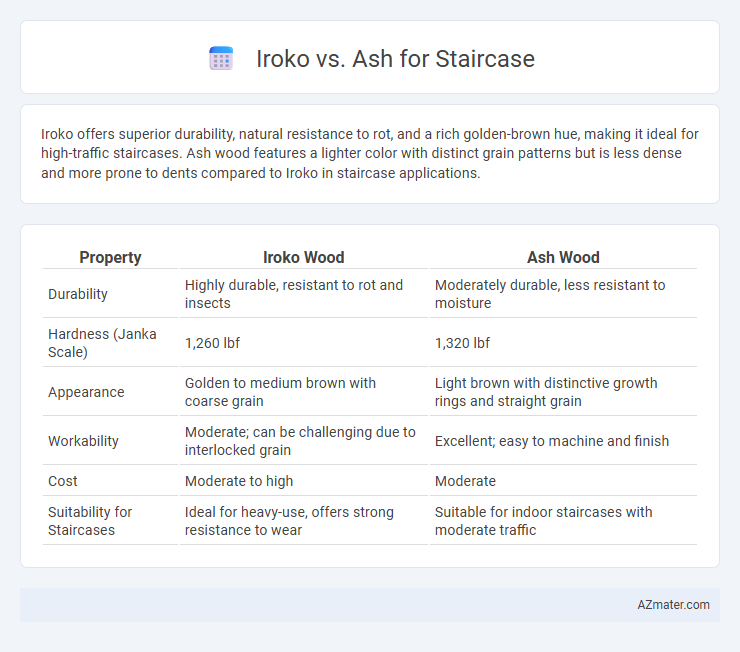Iroko offers superior durability, natural resistance to rot, and a rich golden-brown hue, making it ideal for high-traffic staircases. Ash wood features a lighter color with distinct grain patterns but is less dense and more prone to dents compared to Iroko in staircase applications.
Table of Comparison
| Property | Iroko Wood | Ash Wood |
|---|---|---|
| Durability | Highly durable, resistant to rot and insects | Moderately durable, less resistant to moisture |
| Hardness (Janka Scale) | 1,260 lbf | 1,320 lbf |
| Appearance | Golden to medium brown with coarse grain | Light brown with distinctive growth rings and straight grain |
| Workability | Moderate; can be challenging due to interlocked grain | Excellent; easy to machine and finish |
| Cost | Moderate to high | Moderate |
| Suitability for Staircases | Ideal for heavy-use, offers strong resistance to wear | Suitable for indoor staircases with moderate traffic |
Introduction to Iroko and Ash Wood
Iroko wood, known as African teak, features exceptional durability and natural resistance to decay, making it an excellent choice for staircases subject to heavy foot traffic. Ash wood offers a strong, elastic grain structure with a pale, attractive appearance valued for its shock resistance and ease of finishing in interior applications. Both woods provide distinct aesthetics and performance benefits, with Iroko delivering robust longevity and Ash emphasizing a lighter, more refined look for staircase design.
Key Characteristics of Iroko Wood
Iroko wood, often compared to Ash for staircases, is prized for its high durability and natural resistance to rot and insect attack, making it ideal for both indoor and outdoor use. Its coarse texture and interlocking grain provide a distinct, attractive appearance with a warm golden to medium brown color that darkens over time. Unlike Ash, Iroko has a higher density and hardness, contributing to superior strength and long-lasting structural integrity in staircase applications.
Essential Properties of Ash Wood
Ash wood is prized for staircases due to its exceptional strength, flexibility, and shock resistance, making it ideal for high-traffic areas. Its light color and prominent grain pattern offer aesthetic versatility compared to the darker, denser Iroko, which is more resistant to moisture and decay. Ash's hardness rating of 1320 (Janka scale) provides durable wear resistance, essential for safe and long-lasting staircase construction.
Durability: Iroko vs Ash for Staircase Use
Iroko wood offers exceptional durability for staircases due to its high resistance to moisture, decay, and insect damage, making it ideal for high-traffic areas. Ash, while also durable, provides slightly less hardness and is more prone to wear over time, especially in moisture-prone environments. For staircase use, Iroko delivers superior longevity and structural integrity compared to Ash, ensuring maintenance-free performance in demanding conditions.
Appearance and Aesthetic Appeal
Iroko wood displays a rich golden to medium brown hue that deepens over time, offering a warm and luxurious aesthetic ideal for staircase construction. Ash wood features a lighter, creamy-white color with prominent straight grain patterns, providing a bright and contemporary look for staircases. The dense grain of Iroko creates a more uniform texture while Ash's open grain imparts a natural, airy appeal, allowing homeowners to choose between a classic, sophisticated appearance and a modern, vibrant design.
Workability and Installation Considerations
Iroko offers moderate workability with its coarse grain and natural oils, requiring sharp tools and pre-drilling for screws during staircase installation. Ash exhibits superior workability due to its straight grain and elasticity, allowing easier cutting, sanding, and shaping, which speeds up the fitting process. Installation considerations favor Ash for intricate staircase designs, while Iroko's durability suits heavy-use areas but demands more careful handling.
Cost Comparison: Iroko vs Ash
Iroko wood generally costs more per cubic meter compared to ash, reflecting its durability and resistance to decay, making it a premium choice for staircases. Ash offers a more budget-friendly option while maintaining good strength and a lighter color palette favorable for modern interiors. The price difference between Iroko and ash staircases typically ranges from 20% to 40%, influenced by local availability and seasonal demand fluctuations.
Maintenance and Longevity
Iroko wood offers high durability and resistance to rot, requiring minimal maintenance that typically involves occasional cleaning and oiling to preserve its natural oils and color. Ash, known for its flexibility and strength, demands more frequent sealing and protection from moisture to prevent warping and prolong its lifespan. Both woods provide long-lasting staircase solutions, but Iroko stands out for lower upkeep and superior moisture resistance, contributing to extended longevity in high-traffic areas.
Environmental Impact and Sustainability
Iroko wood, known for its durability and resistance to decay, is harvested primarily from West African forests, raising concerns about deforestation and habitat loss if not sourced sustainably. Ash, sourced mainly from temperate regions, is often more readily available from managed forests with certifications like FSC, promoting responsible forestry practices and lower environmental footprint. Choosing ash for staircases typically supports better sustainability credentials due to faster growth rates and more efficient regeneration compared to the slower-growing Iroko species.
Choosing the Best Wood for Your Staircase
Iroko offers exceptional durability and a rich golden-brown hue, making it ideal for staircases that require strength and aesthetic appeal. Ash provides a lighter, more uniform texture with excellent shock resistance, perfect for modern designs emphasizing natural light. When choosing the best wood for your staircase, prioritize factors such as hardness (Iroko rates around 1720 Janka, Ash about 1320 Janka), grain appearance, and maintenance requirements to match your functional and design needs.

Infographic: Iroko vs Ash for Staircase
 azmater.com
azmater.com